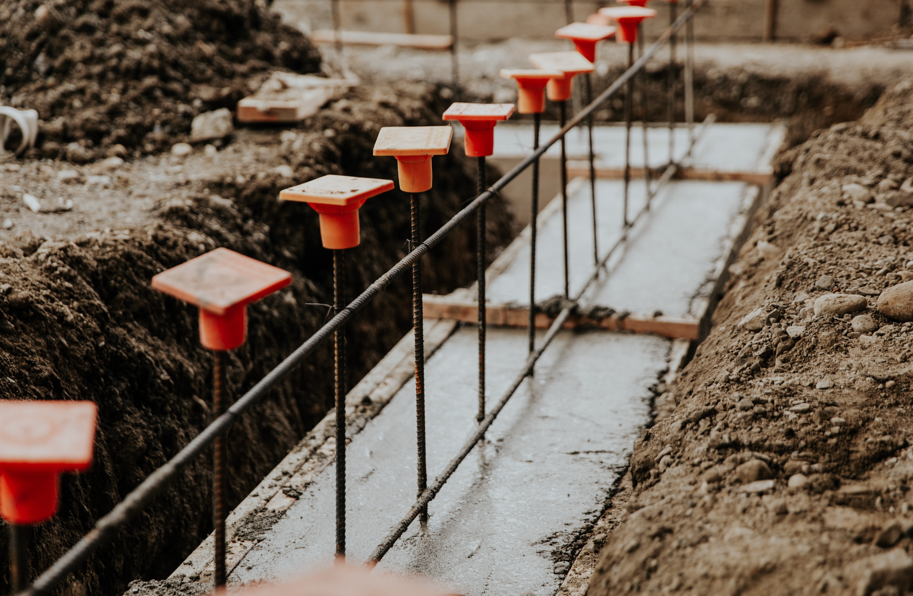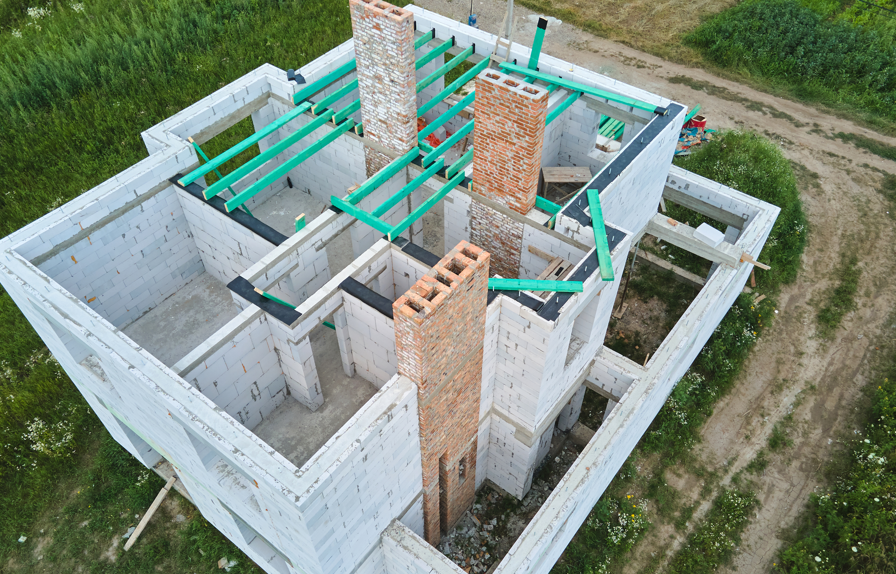What is a Stem Wall? Understanding Its Role in Building Foundations
- Staff Desk
- Jul 21
- 10 min read

A stem wall is a short, sturdy wall that connects a building’s foundation footing to the structure above it. It acts as a crucial link between the underground foundation and the visible part of the house, providing stability and elevating the structure off the ground. This foundation element is typically made of concrete or concrete blocks and plays a key role in supporting the weight of the building while helping to prevent moisture problems.
Stem walls are commonly used in crawl space foundations, offering elevated support that can protect homes from flooding and soil movement. Because they provide a level platform on uneven terrain, stem walls are favored in areas with challenging ground conditions or for homes requiring extra durability at the foundation level.
Understanding what a stem wall is helps clarify why it remains a foundational element in many modern construction projects. Its strength, durability, and ability to support heavy loads make it a reliable choice for ensuring the long-term stability and safety of a structure.
Definition of a Stem Wall
A stem wall is a short vertical wall that connects a building’s foundation footing to its structural framing. It plays a crucial role in supporting the building’s weight and elevating the structure above ground level. Its design impacts both stability and moisture control.
Key Characteristics
A stem wall typically rises several feet above the footing, bridging the gap between the concrete foundation and the building’s above-ground walls. It is usually made of poured concrete or concrete masonry units (CMU).
The height of a stem wall often corresponds to the height of a crawl space or basement. It provides a level base for framing and distributes structural loads evenly.
Stem walls also help prevent moisture intrusion by raising the structure above soil dampness. This is especially important in regions prone to heavy rainfall or flood risk.
Comparison With Other Foundation Types
Unlike a full foundation wall, which extends to the ground surface and supports a full basement, a stem wall is shorter and often part of a crawl space foundation.
Monolithic slab foundations skip stem walls entirely by combining footing and slab in one continuous pour at ground level. This offers less elevation and crawl space access.
Compared to pier foundations, which only support specific points, stem walls provide continuous load-bearing support along the perimeter. This adds stability for large or heavy structures.
Foundation Type | Stem Wall | Monolithic Slab | Pier Foundation |
Height Above Footing | Several feet | Ground level | Minimal |
Crawl Space | Common | Rare | Possible |
Load Distribution | Continuous | Uniform slab | Point loads |
Moisture Protection | Elevated structure | Less effective | Depends on design |
Components of a Stem Wall
A stem wall includes several critical elements that work together to provide strength, stability, and protection. Proper materials and construction techniques ensure the wall can support weight and resist environmental factors like moisture.
Reinforcement Materials
Reinforcement in a stem wall primarily consists of steel rebar, which enhances the wall’s tensile strength. The rebar is embedded within the concrete to resist bending and cracking under load.
The placement of rebar follows specific spacing and sizing requirements set by building codes. This ensures the wall can handle structural stresses from the weight of the building and soil pressure.
In some cases, welded wire mesh may be used in combination with or instead of rebar. Proper reinforcement prevents structural failure and extends the lifespan of the foundation.
Concrete and Block Construction
Stem walls are commonly constructed using poured concrete or concrete masonry units (blocks). Poured concrete offers a continuous, monolithic structure that is highly durable.
Concrete blocks allow for faster construction and easier modifications but require mortar joints and additional reinforcement. Both types rest on a concrete footing, which distributes the building’s weight evenly.
Concrete mix design must meet strength requirements, typically a minimum compressive strength of 3,000 to 4,000 psi. Adequate curing time is critical to develop the concrete’s full strength.
Waterproofing and Damp Proofing

Water resistance is essential in stem wall construction to prevent moisture damage to the foundation and interior spaces. Waterproofing membranes or coatings are often applied to the exterior of the wall.
Damp proofing involves applying sealants or barriers that reduce water vapor transmission but are not fully waterproof. Proper drainage systems and grading away from the wall complement these treatments.
Materials commonly used include bituminous coatings, liquid-applied membranes, or sheet membranes. Consistent application and inspection ensure long-term protection against water infiltration.
Function and Purpose in Construction
A stem wall connects the foundation footing to the building’s structure, performing multiple roles. It supports vertical loads, elevates the structure above ground level, and acts as a barrier against moisture intrusion. Each function contributes directly to the building’s strength and durability.
Load Bearing Properties
A stem wall transfers the weight of the structure from the upper walls down to the footing and soil below. It must be strong enough to support heavy loads without cracking or shifting.
Typically constructed from concrete or concrete blocks, stem walls distribute weight evenly. This prevents uneven settling that could cause structural damage.
The wall also resists lateral forces from soil and wind. Its stability is crucial in maintaining the integrity of the entire foundation system.
Elevation and Support
Stem walls raise the building off the ground, creating a level platform on uneven or sloping terrain. This elevation helps prevent direct contact between the structure and soil.
By lifting the structure, stem walls allow for crawl spaces or basements beneath the building. These spaces provide room for mechanical systems, insulation, and access for repairs.
Raising the building also improves air circulation below the floors, reducing dampness that can damage materials. Proper elevation is key to long-term durability.
Protection Against Moisture
Stem walls serve as a physical barrier that helps keep moisture from soil away from the structure. Moisture intrusion can lead to rotting, mold, and other damage inside the building.
They often include waterproofing layers or coatings to enhance protection. Elevating the structure above grade further reduces the risk of water exposure.
This moisture control is especially important in wet or flood-prone areas. By limiting water penetration, stem walls contribute to a healthier, more durable building environment.
Common Applications of Stem Walls
Stem walls are used in various construction projects where elevated foundations or added structural support are necessary. Their ability to adapt to different soil and site conditions makes them valuable in multiple contexts.
Residential Buildings
Stem walls are widely used in residential construction to create a stable base above ground level. This approach is especially beneficial in areas prone to moisture or flooding. By elevating the floor, stem walls help protect the structure from water damage and provide ventilation beneath the home.
They are commonly paired with crawl spaces, offering easier access to plumbing and electrical systems. The combination of a poured concrete footing and vertical wall provides solid support to the framing above. Reinforced concrete stem walls also help resist shifting in unstable soils, enhancing durability.
Commercial Structures
In commercial projects, stem walls serve as a reliable foundation solution for buildings requiring precise load distribution. They accommodate heavier structural loads due to their reinforced design and can be adjusted in height to suit sloped or uneven sites.
Stem walls allow for raised floors, which can be important in facilities that need protection from ground moisture or require space for utility installations. Their construction also enables integration with different foundation types, like slabs and footings, contributing to flexibility in architectural design and engineering requirements.
Retaining Walls
Stem walls function effectively as retaining walls by holding back soil and providing lateral support. Their strength comes from the reinforced concrete combined with well-designed footings, making them capable of withstanding significant soil pressure.
They are often used in landscaping and infrastructure projects to manage slopes, prevent erosion, and define property boundaries. When designed properly, stem walls as retaining walls can also include drainage features that reduce hydrostatic pressure behind the wall, enhancing long-term stability.
Design Considerations
A stem wall’s design must account for environmental and site-specific factors to ensure structural stability and longevity. Critical elements include the type of soil supporting the foundation and the regional climate conditions influencing material choice and construction methods.
Soil Conditions
The soil type beneath and around a stem wall directly influences its design and performance. Cohesive soils like clay can retain water and expand, exerting pressure on the wall. In contrast, sandy soils drain well but may shift, requiring additional reinforcement.
Engineers assess soil bearing capacity to determine the necessary footing size and depth. Poor soil conditions might demand deeper footings or pilings. Drainage around the foundation is crucial to prevent water buildup, which can weaken the soil and lead to settling or cracking.
Proper soil testing informs decisions on stem wall thickness, reinforcement, and moisture barriers. This ensures the wall can support the structure above and resist soil-related stresses over time.
Climate Factors
Climate affects material selection, durability measures, and construction techniques for stem walls. In regions with freeze-thaw cycles, concrete must resist cracking due to expansion of water within the material.
Humidity and precipitation levels influence waterproofing strategies. Areas prone to flooding require stem walls to be elevated and sealed against water infiltration. Conversely, arid climates may prioritize thermal resistance to reduce heat transfer.
Insulation requirements depend on temperature extremes. Incorporating vapor barriers and moisture-resistant membranes helps prevent mold and deterioration. The choice of concrete mix and curing methods also adapts to local climate conditions to maintain structural integrity.
Installation and Construction Process

The installation of a stem wall involves several precise steps to ensure the foundation provides proper support and durability. Preparation of the site, accurate formwork, concrete pouring, and proper curing methods are essential for a stable structure.
Site Preparation
The process begins with excavating a trench to the required depth and width based on engineering specifications. This trench forms a base for the concrete footing, which must be level and stable.
Next, any loose soil or debris is removed to provide a solid foundation. Contractors may install reinforcement like rebar in the trench before pouring concrete to improve strength and prevent cracking.
Proper drainage and soil compaction around the site are also prepared during this phase to avoid future settling or water damage.
Formwork and Pouring
Formwork consists of wooden or metal molds shaped to the exact dimensions of the stem wall. These forms hold the wet concrete in place until it hardens.
The concrete mix is poured into the forms, usually in layers, to avoid air pockets and ensure uniformity. Vibrating tools may be used to settle the concrete and eliminate voids.
Reinforcement bars embedded during pouring add tensile strength to the structure, improving its resistance to stresses from soil movement or load bearing.
Curing and Finishing
After pouring, the concrete must cure under controlled conditions to reach maximum strength. This typically involves keeping the wall moist for several days using water sprays or covering membranes.
Finishing touches include smoothing exposed surfaces and removing the formwork once curing is sufficient. The cured stem wall provides a level, stable base for the rest of the building’s structure.
Regular inspection during this phase ensures there are no cracks or defects that could compromise the foundation’s integrity.
Maintenance and Repair
Stem walls require regular attention to ensure they remain structurally sound. Early detection of issues and timely fixes prevent costly damage. Specific inspection, awareness of typical problems, and targeted repair techniques are essential for longevity.
Inspection Techniques
Visual inspection is the first step in evaluating stem walls. Look closely for hairline cracks, spalling, or signs of moisture infiltration. Use a flashlight and magnifier to check dark or hard-to-see areas.
A moisture meter can identify hidden damp spots that suggest water penetration. Regular checks should occur biannually, especially after heavy rains or seasonal changes.
Professional inspections may include more advanced methods such as infrared thermography or soil testing to detect subsurface issues impacting the foundation’s stability.
Common Issues
Cracks are the most frequent problem, ranging from minor shrinkage lines to wider structural fractures. Vertical cracks often result from settlement, while horizontal cracks might indicate soil pressure or water damage.
Water intrusion leads to efflorescence, mold growth, and eventual weakening of the concrete. Poor drainage around the foundation accelerates such deterioration.
Other issues include concrete spalling caused by freeze-thaw cycles or corrosion of embedded steel reinforcement. Shifting soil or improper compaction during construction can also cause stem wall movement or gaps.
Remediation Methods
Minor cracks can often be sealed with epoxy injections or polyurethane foam to prevent water entry and further damage. Surface repairs using patching compounds restore appearance and integrity.
For more severe structural damage, underpinning or rebuilding sections of the stem wall may be necessary. This process stabilizes the foundation by extending footing depth or reinforcing weak areas.
Waterproof coatings and proper drainage systems should be installed to protect against moisture. Maintaining gutters, grading, and sump pumps helps prevent water-related issues.
Regular maintenance combined with prompt repair treatments extends the life of a stem wall and preserves the building’s stability.
Benefits of Using Stem Walls
Stem walls offer key advantages that improve the foundation’s performance and adaptability in various construction settings. They address common issues such as soil movement and moisture intrusion while allowing flexible design choices.
Structural Stability
Stem walls enhance a building’s structural integrity by providing a solid, raised base that evenly distributes weight. This setup reduces the risk of foundation settlement or cracking, especially on uneven or shifting soils. Because stem walls elevate the structure, they help protect against flooding and soil erosion. The raised foundation acts as a barrier, preventing water from reaching the interior, which minimizes potential damage and mold growth.
Additionally, stem walls support the building’s load through a continuous concrete or masonry wall connected to a deep footing. This connection increases resistance to lateral forces like wind and seismic activity, improving overall durability.
Versatility
Stem walls accommodate different site conditions and architectural designs better than many foundation types. Their raised design creates a crawl space that allows easy access to plumbing, electrical wiring, and HVAC systems without major excavation.
They can be combined with various flooring systems, including slabs and wood framing, providing flexibility for builders and homeowners. Stem walls also perform well in areas with moderate to steep slopes or expansive soils, where monolithic slabs might struggle.
This adaptability makes stem walls suitable for residential and commercial projects, especially when protection from moisture and soil movement is a priority.
Potential Drawbacks and Limitations
Stem wall foundations require additional resources and time compared to simpler foundation types. These factors influence project budgeting and scheduling, especially for homeowners and builders balancing multiple priorities.
Cost Considerations
Stem wall foundations generally cost more than monolithic slab foundations. They require more materials such as concrete and reinforcing steel, which increases direct expenses.
Labor costs also rise because stem walls demand skilled work for precise construction. This involves setting forms, pouring concrete in layers, and ensuring proper curing.
Additional costs may come from the need for proper insulation and pest control measures, which are crucial to maintaining energy efficiency and protecting the crawl space underneath. In summary, stem walls involve higher upfront investment largely due to material use and increased labor complexity.
Time Factors
Building a stem wall foundation takes longer than pouring a monolithic slab. The process involves multiple steps, including setting forms, pouring concrete in stages, and allowing time for each layer to cure. This extended timeframe requires coordination and can delay subsequent construction phases like framing and utilities installation.
Inspections by local authorities are often more frequent with stem walls due to their complexity, which can add to the schedule. Project managers need to account for these timing considerations when planning to avoid bottlenecks and increased holding costs on the site.



Comments